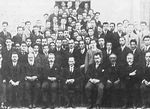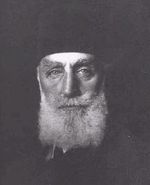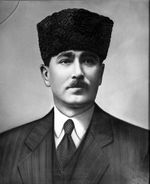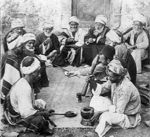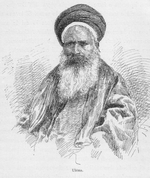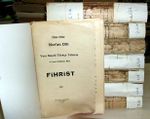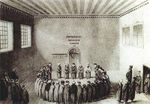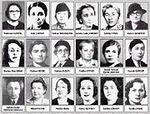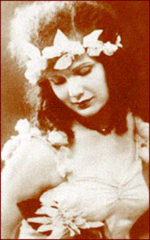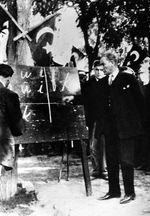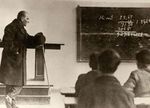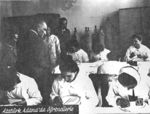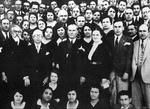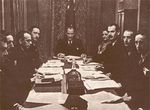إصلاحات أتاتورك
| ||
|---|---|---|
معرض: صور، تسجيلات صوتية ومرئية |
||
إصلاحات أتاتورك (تركية: Atatürk Devrimleri) كانت سلسلة من التغييرات السياسية والقانونية والدينية والثقافية والاجتماعية وفي السياسات الاقتصادية بهدف تحويل جمهورية تركيا الجديدة إلى أمة-دولة علمانية وعصرية، تنفيذها تحت قيادة مصطفى كمال أتاتورك حسب الأيديولوجية الكمالية. كان محور هذه الإصلاحات هو الاعتقاد بأنه يتعين على المجتمع التركي أن يغرب نفسه سياسياً وثقافياً من أجل التحديث.[1] تضمنت الإصلاحات السياسية عدداً من التغييرات المؤسسية الأساسية التي أنهت العديد من التقاليد، واتبعت برنامجاً تم التخطيط له بعناية لكشف النظام المعقد الذي تطور عبر القرون.[2]
بدأت الإصلاحات بتحديث الدستور، والذي تضمن تفعيل دستور 1924 الجديد والذي حل محل دستور 1921، وتبني القوانين الأوروپية والولاية القضائية المطلوبة للجمهورية الجديدة. أجري هذا من خلال العلمانية وتحديث الإدارة، مع التركيز بشكل خاص على المنظومة التعليمية.
تاريخياً، اتبعت إصلاحات أتاتورك التنظيمات العثمانية، والتي تعني إعادة التنظيم، والتي بدأت عام 1839 وانتهت الفترة المشروطية الأولى عام 1876،[3] فضلاً عن الجهود المختلفة للعلمانية والديمقراطية والتحديث خلال الفترة المشروطية الثانية من 1908 حتى 1913. كما أُجريت مجموعة أخرى من الإصلاحات الاجتماعية والاقتصادية والإدارية في 14 أبريل 1987 في سعي تركيا للانضمام إلى الاتحاد الأوروپي.
الأهداف
إصلاح الإسلام
The Ottoman Empire was an Islamic state in which the head of the state, the Sultan, also held the position of Caliph. The social system was organized around the millet structure. The millet structure allowed a great degree of religious, cultural and ethnic continuity across the society but at the same time permitted the religious ideology to be incorporated into the administrative, economic and political system. One can define this way of life as Islamism (Political Islam): "the belief that Islam should guide social and political as well as personal life".[4]
There were two sections of the elite group at the helm of the discussions for the future. These were the "Islamist reformists" and the "Westerners". Many basic goals were common to both groups. Some secular intellectuals, and even certain reform-minded Muslim thinkers, accepted the view that social progress in Europe had followed the Protestant reformation, as expressed in François Guizot's Histoire de la civilisation en Europe (1828). The reform-minded Muslim thinkers concluded from the Lutheran experience that the reform of Islam was imperative. Abdullah Cevdet and Kılıçzâde İsmail Hakkı (İsmail Hakkı Kılıçoğlu), who were westernist thinkers, took their inspiration rather from the subsequent marginalization of religion in European societies.[5] To them, a reformed religion had only a temporary role to play as an instrument for the modernization of society, after which it would be cast aside (from public life and limited to personal life).[5] All-out attack on Islam in a predominantly Muslim society was injudicious. A reconfigured version of Islam could be co-opted to serve as a vehicle for progress and enlightenment. Atatürk's achievement was to amplify the common ground and put the country on a fast track of reforms. Implemented reforms had implications on the Islamic world. One significant implication involved the abolition of the Ottoman Caliphate in 1924.[6])
التغريب
The Young Turks and other Ottoman intellectuals asked the question of the position of the empire regarding the West (primarily taken to mean Christian Europe).[7] The West was symbolized by intellectual and scientific ascendancy, and provided the blueprint for the ideal society of the future.[7] Reformers declared the question was decided: Turkey would look to the West.
الإصلاح السياسي
Until the moment the republic was formally proclaimed, the Ottoman Empire was still in existence, with its heritage of religious and dynastic authority. The dynasty was abolished by the Ankara Government, but its traditions and cultural symbols remained active among the people (though less so among the elite).
The elements of the political system visioned by Atatürk's Reforms developed in stages, but in 1935, when the last part of the Atatürk's Reforms removed the reference to Islam; the political system became a secular (2.1) and democratic (2.1), republic (1.1) that derives its sovereignty (6.1) from the people. The sovereignty rests with the Turkish Nation, who delegates its exercise to an elected unicameral parliament (position in 1935), the Turkish Grand National Assembly. The preamble also invokes the principles of nationalism, defined as the "material and spiritual well-being of the Republic" (position in 1935). The basic nature of the Republic is laïcité (2), social equality (2), equality before law (10), and the indivisibility of the Republic and of the Turkish Nation (3.1)." Thus, it sets out to found a unitary nation-state (position in 1935) based on the principles of secular democracy. There exists separation of powers between the Legislative Power (7.1), Executive Power (8.1), and Judicial Power (9.1) of the state. The separation of powers between the legislative and the executive is a loose one, whereas the one between the executive and the legislative with the judiciary is a strict one.
الجمهورية (الديمقراطية التمثيلية)
The most fundamental reforms allowed the Turkish nation to exercise popular sovereignty through representative democracy. The Republic of Turkey ("Türkiye Cumhuriyeti") was proclaimed on October 29, 1923 by the Turkish Grand National Assembly.
الجمهورية الدستورية (1921 و1924)
The model for the system is Constitutional Republic. In the Turkish Constitutional Republic, government created and controlled by the Law of a Constitution.
The Turkish Constitution of 1921 was the fundamental law of Turkey for a brief period from 1921 to 1924. It was ratified by the Grand National Assembly of Turkey in January 1921. It was a simple document consisting of only 23 short articles. The major driving force behind the preparation of a 1921 Constitution that derived its sovereignty from the nation and not from the Sultan, the absolute monarch of the Ottoman Empire. The 1921 Constitution also served as the legal basis for the Turkish War of Independence during 1919–1923, since it would refute the principles of the Treaty of Sèvres of 1918 signed by the Ottoman Empire, by which a great majority of the Empire's territory would have to be ceded to the Entente powers that had won the First World War. In October 1923 the constitution was amended to declare Turkey to be a republic.
In April 1924, the constitution was replaced by an entirely new document, the Turkish Constitution of 1924.
إلغاء السلطنة (1922)
On November 1, 1922, the Ottoman Sultanate was abolished by the Turkish Grand National Assembly and Sultan Mehmed VI departed the country. This allowed the Turkish nationalist government in Ankara to become the sole governing entity in the nation.
Mehmed VI sought refuge aboard the British warship Malaya on November 17.[8]
النظام متعدد الأحزاب
The bicameral system of the Ottoman parliament—composed of an upper house, the Senate of viziers, assigned by the Sultan, and the lower house, the Chamber of Deputies, selected by two-level elections—was dissolved, which had already been defunct since the Allied occupation of Istanbul in 1920 and consequently.
The foundation of the Turkish Grand National Assembly followed the dissolution of the lower house of the Ottoman parliament. The new system, which gave primacy to national independence and popular sovereignty, established the offices of Prime Minister and President while placing legislative power within a unicameral Grand National Assembly. The Assembly was elected by direct election using proportional representation. It was based on Party system, which governance by political parties was adapted. The only political party was the "Peoples Party", which was founded by Atatürk in the initial years of the independence war. On 9 September 1923 it was renamed the Republican People's Party (Turkish: Cumhuriyeti Halk Partisi). The single-party regime was established de facto after the adoption of the 1924 constitution.
The term "de facto single-party state" is used to define the period as the dominant-party system (in this case Republican People's Party), unlike the single-party state, allowed democratic multiparty elections, but existing practices effectively prevent the opposition from winning the elections. The Republican People's Party was the only elected party in the parliament between 1925 and 1945. There were other parties. A notable example was Nezihe Muhittin who founded the first women's party Kadınlar Halk Fırkası ("Women's People Party") in June 1923. Women's People Party was not legalized as the Republic was not officially declared. The Progressive Republican Party (Terakkiperver Cumhuriyet Fırkası) was established between 1924 and 1925 under the parliament. Its leader was Kazım Karabekir. It was banned after the Sheikh Said rebellion. The Liberal Republican Party (Serbest Cumhuriyet Fırkası) established in 1930 under the parliament, and was later dissolved by its founder.
The effective multi-party period began in 1945; the next year, the Republican People's Party won the first multi-party elections. In the 1950 elections, the Democratic Party won, becoming the first opposition party to win elections.
الاستقلال المدني (السيادة الشعبية)
The establishment of popular sovereignty involved confronting centuries-old traditions. The reform process was characterized by a struggle between progressives and conservatives. The changes were both conceptually radical and culturally significant. In the Ottoman Empire, the people of each millet had traditionally enjoyed a degree of autonomy, with their own leadership, collecting their own taxes and living according to their own system of religious/cultural law. The Ottoman Muslims had a strict hierarchy of ulama, with the Sheikh ul-Islam holding the highest rank. A Sheikh ul-Islam was chosen by a royal warrant among the qadis of important cities. The Sheikh ul-Islam issued fatwas, which were written interpretations of the Quran that had authority over the community. The Sheikh ul-Islam represented the law of shariah. This office was in the Shar’iyya wa Awqaf Ministry. Sultan Mehmed VI's cousin Abdulmecid continued on as Ottoman Caliph.
Besides the political structure; as a part of civic independence, religious education system was replaced by a national education system on March 3, 1924, and The Islamic courts and Islamic canon law gave way to a secular law structure based on the Swiss Civil Code, which is detailed under their headings.
إلغاء الخلافة (1924) والنظام الملي
In the secular state or country purports to be officially neutral in matters of religion, supporting neither religion nor irreligion and claims to treat all its citizens equally regardless of religion, and claims to avoid preferential treatment for a citizen from a particular religion/nonreligion over other religions/nonreligion.[9] Reformers followed the European model (French model) of secularization. In European model of secularizing; states typically involves granting individual religious freedoms, disestablishing state religions, stopping public funds to be used for a religions, freeing the legal system from religious control, freeing up the education system, tolerating citizens who change religion or abstain from religion, and allowing political leadership to come to power regardless of religious beliefs.[10] In establishing a secular state, the Ottoman Caliphate, held by the Ottomans since 1517, abolished and to mediate the power of religion in the public sphere (including recognized minority religions in the Treaty of Lausanne) left to the Directorate for Religious Affairs. Under the reforms official recognition of the Ottoman millets withdrawn. Shar’iyya wa Awqaf Ministry followed the Office of Caliphate. This office was replaced by the Presidency of Religious Affairs.
The abolishing of the position of Caliphate and Sheikh ul-Islam was followed by a common, secular authority. Many of the religious communities failed to adjust to the new regime. This was exacerbated by the emigration or impoverishment, due to deteriorating economic conditions. Families that hitherto had financially supported religious community institutions such as hospitals and schools stop doing so.
ادارة الشئون الدينية
Atatürk's reforms define laïcité (as of 1935) as permeating both the government and the religious sphere. Minority religions, like the Armenian or Greek Orthodoxy are guaranteed protection by the constitution as individual faiths (personal sphere), but this guarantee does not give any rights to any religious communities (social sphere). (This differentiation applies to Islam and Muslims as well. Atatürk's reforms, as of 1935, assume the social sphere is secular.)
The Treaty of Lausanne, the internationally binding agreement of the establishment of the Republic, does not specify any nationality or ethnicity. It simply identifies non-Muslims in general and provides the legal framework which gives certain explicit religious rights to Jews, Greeks, and Armenians without naming them.
According to the Directorate for Religious Affairs, it was created "to execute the works concerning the beliefs, worship, and ethics of Islam, enlighten the public about their religion, and administer sacred worship places". However, this can also be likened to the Soviets who placed religious authorities managed by the state, to direct people to a form of "state-approved" religion.
This is also true for other religions, as some argue that even Christians were treated better under the Ottoman Empire than under the modern Turkish Republic. Regardless, the government asserted the equality of religions and rights of worship to all Turkish citizens in their own private space to the protection of the Republic. The state protected freedom of worship while itself standing aloof of any form of religious influence. Kemalist ideology targeted political Islam, but it posed a threat to the independence of the state and its ability to govern with equal concern for all.
الادارة العامة
العاصمة الجديدة
The reform movement turned its back on the perceived corruption and decadence of cosmopolitan Istanbul and its Ottoman heritage,[11] as well as electing to choose a capital more geographically centered in Turkey. During the disastrous 1912–13 First Balkan War, Bulgarian troops had advanced to Çatalca, mere miles from Istanbul, creating a fear that the Ottoman capital would have to be moved to Anatolia; the reform movement wanted to avoid a similar incident with Turkey.[12]
تأسست العاصمة الجديدة في أنقرة في 13 أكتوبر 1923.
الاصلاحات الاجتماعية
Some social institutions had religious overtones, and held considerable influence over public life. Social change also included centuries old religious social structures that has been deeply rooted within the society, some were established within the state organisation of the Ottoman Empire. The Kemalist reforms brought effective social change on women's suffrage.
النطاق العام
In the Ottoman public sphere religious groups exerted their power. Public sphere is an area in social life where individuals together to freely discuss and identify societal problems, and through that discussion influence political action. It is "a discursive space in which individuals and groups congregate to discuss matters of mutual interest and, where possible, to reach a common judgment."[13] Atatürk's Reforms target the structure of the public space.
The construction of a secular nation-state was a huge enterprise in a conservative Muslim society, though Atatürk Reforms benefit from the elaborate blueprints for a future society prepared by the Ottoman proponents of scientism during the Second Constitutional Period. [14] Much of Ottoman society dismissed this blueprint as the ruminations of marginal intellectuals, and the religious establishment denounced them as heresy, but the conditions of victory in 1922 (The Republic) brought into being a situation necessary for their implementation by a true believer (true believer = reform the religion to its original form).[14] Highlighting the public's lack of knowledge regarding Kemal's intentions, the public cheered: "We are returning to the days of the first caliphs." [15]
الشعارات الدينية
The Ottoman Empire had a social system based on religious affiliation. The religious insignia extended to every social function. It was common to wear clothing that identified the person with their own particular religious grouping and accompanied headgear which distinguished rank and profession throughout the Ottoman Empire. The turbans, fezes, bonnets and head-dresses surmounting Ottoman styles showed the sex, rank, and profession (both civil and military) of the wearer. These styles were accompanied with a strict regulation beginning with the reign of سليمان القانوني. Sultan Mahmud II followed on the example of Peter the Great in Russia in modernizing the Empire and used the dress code of 1826 which developed the symbols (classifications) of feudalism among the public. These reforms like that of Peter I of Russia or السلطان محمود الثاني, was achieved through introduction of the progressive customs by decrees, while banning the traditional customs. The view of their social change proposed; if the permanence of secularism was to be assured by removal of persistence of traditional cultural values (the religious insignia), a considerable degree of cultural receptivity by the public to the further social change could be achieved. The dress code gave a chance for the removal of persistence of traditional values in the society.
Atatürk's Reforms defined a non-civilized (non-scientific, non-positivist) person as one who functioned within the boundaries of superstition. The ulema was not a scientific group, and it was acting according to superstitions developed throughout centuries. Their name was "Gerici", literally means "backward", but it was used to mean bigot. On February 25, 1925 parliament passed a law stating that religion was not to be used as a tool in politics. The question became how this law could be brought to life in a country whose scholars are dominated by the ulema. Kemalist ideology waged a war against superstition by banning the practices of the ulema and promoting the civilized way ("westernization"), with establishing lawyers, teachers, doctors. The ban on the ulema's social existence came in the form of dress code. The strategic goal was to change the large influence of the ulema over politics by removing them from the social arena. However, there was the danger of being perceived as anti-religious. Kemalists defended themselves by stating "Islam viewed all forms of superstition (non-scientific) nonreligious". The ulema's power was established during the Ottoman Empire with the conception that secular institutions were all subordinate to religion; the ulema were emblems of religious piety, and therefore rendering them powerful over state affairs.[16] Kemalists claimed:
The state will be ruled by positivism not superstition.[16]
A good example was the practice of medicine. Kemalists wanted to get rid of superstition extending to herbal medicine, potion, and religious therapy for mental illness, all of which were practised by the ulema. They excoriated those who used herbal medicine, potions, and balms, and instituted penalties against the religious men who claimed they have a say in health and medicine. On September 1, 1925, the first Turkish Medical Congress was assembled, which was only four days after Mustafa Kemal was seen on August 27 at Inebolu wearing a modern hat and one day after the Kastamonu speech on August 30.
Official measures were gradually introduced to eliminate the wearing of religious clothing and other overt signs of religious affiliation. Beginning in 1923, a series of laws progressively limited the wearing of selected items of traditional clothing. Mustafa Kemal first made the hat compulsory to the civil servants.[17] The guidelines for the proper dressing of students and state employees (public space controlled by state) was passed during his lifetime. After most of the relatively better educated civil servants adopted the hat with their own he gradually moved further. The Hat Law of 1925 introduced the use of Western style hats instead of the fez. Legislation did not explicitly prohibit veils or headscarves and focused instead on banning fezzes and turbans for men. Another control on the dress was passed in 1934 with the law relating to the wearing of 'Prohibited Garments'. It banned religion-based clothing, such as the veil and turban, while actively promoting western-style attire.
النصوص الدينية والصلاة والمراجع
All printed Qurans in Turkey were in Classical Arabic (the sacred language of Islam) at the time. Previous Qurans in Turkish that were not made public existed. There was a rare polyglot Quran written in Arabic, Persian, Turkish and Latin in the tetrapla style, prepared by savant Andrea Acolutho of Bernstadt and printed at Berlin in 1701.[18] The major point of Atatürk's Reform come with this quote: "...teaching religion in Turkish to Turkish people who had been practising Islam without understanding it for centuries"[19] Turkish translations published in Istanbul created controversy In 1924. Several renderings of the Quran in the Turkish language were read in front of the public.[20] These Turkish Qurans were fiercely opposed by religious conservatives. This incident impelled many leading Muslim modernists to call upon the Turkish Parliament to sponsor a Quran translation of suitable quality.[21] The Parliament approved the project and the Directorate of Religious Affairs enlisted, Mehmet Akif Ersoy, to compose a Quran translation and an Islamic scholar Elmalılı Hamdi Yazır to author a Turkish language Quranic commentary (tafsir) titled "Hak Dini Kur'an Dili." Ersoy declined the offer and destroyed his work, to avoid the possible public circulation of a transliteration which may remotely be faulty. Only in 1935 did the version read in public find its way to print.
The program also involved implementing a Turkish adhan, as opposed to the conventional Arabic call to prayer. The Arabic adhan was replaced with the following:
Tanrı uludur
Şüphesiz bilirim, bildiririm
Tanrı'dan başka yoktur tapacak.
Şüphesiz bilirim, bildiririm;
Tanrı'nın elçisidir Muhammed.
Haydin namaza, haydin felaha,
Namaz uykudan hayırlıdır.
Following the conclusion of said debates, the Presidency of Religious Affairs (Diyanet İşleri Başkanlığı) released an official mandate on July 18, 1932, announcing the decision to all the mosques across Turkey, and the practice was continued for a period of 18 years. On July 16, 1950, a new government was sworn in, led by Adnan Menderes, which restored Arabic as the liturgical language.
The reformers dismissed the imam assigned to the Turkish Grand National Assembly, saying that prayer should be performed in a mosque, not in the parliament.[22] They also removed the "references to religion" from the decorum. The only Friday sermon (khutba) ever delivered by a Turkish head of state was given by Atatürk; this took place at a mosque in Balıkesir during the election campaign. The reformers said that "to repeat the sermons [by a politician in the parliament] of a thousand years ago was to preserve backwardness and promote nescience."[22]
الهيئات الدينية
The abolishment of Caliphate removed the highest religious-political position. This act left the Muslim brotherhoods (Muslim associations working as a society of Muslim believers for any purpose) who were institutionalized (religious-political representation) under the convents and the dervish lodges without higher organizing structure.
The reformers assumed that the original sources, now available in Turkish, would render the orthodox religious establishment (the ‘ulamā’) and the Ṣūfī ṭarīqas obsolete, and thus help to privatize religion as well as produce a reformed Islam (Turkish Reformation = Turkified).[23] In 1925 institutions of religious covenants and dervish lodges were declared illegal.[24]
The reformers imagined that the elimination of the orthodox and Ṣūfī religious establishments, along with traditional religious education, and their replacement with a system in which the original sources were available to all in the vernacular language, would pave the way for a new vision of Islam open to progress and modernity and usher in a society guided by modernity.[25]
Following the multi-party period in 1950 the religious establishments (Islamist movements) returned. The Gülen movement is a transnational religious and social movement led by Turkish Islamic scholar Fethullah Gülen, which his movement is mainly active in education and interfaith dialogue however there are also substantial investments in media, finance, and for profit health clinics.[26]
حقوق المرأة
During a meeting in the early days of the new republic, Atatürk proclaimed:
To the women: Win for us the battle of education and you will do yet more for your country than we have been able to do. It is to you that I appeal.
To the men: If henceforward the women do not share in the social life of the nation, we shall never attain to our full development. We shall remain irremediably backward, incapable of treating on equal terms with the civilizations of the West.[27]
In the following years of Atatürk's Reforms women's rights campaigners in Turkey differed from their sisters (and sympathetic brothers) in other countries. Rather than fighting directly for their basic rights and equality, they saw their best chance in the promotion and maintenance of Atatürk's Reforms, with its espousal of secular values and equality for all, including women.[28]
المشاركة المتساوية
The Ottoman society was a traditional one and the women had no political rights, even after the Second Constitutional Era in 1908. During the early years of the Turkish Republic educated women struggled for political rights. One notable female political activist was Nezihe Muhittin who founded the first women's party in June 1923, which however was not legalized because the Republic was not officially declared.
With intense struggle, the Turkish women achieved voting rights in local elections by the act of 1580 on 3 April 1930.[29] Four years later, through legislation enacted on 5 December 1934, they gained full universal suffrage, earlier than most other countries.[29] The reforms in the Turkish civil code, including those affecting women's suffrage, were "breakthroughs not only within the Islamic world but also in the western world".[30]
In 1935, in the general elections Eighteen female MP's joined the parliament, at a time when women in a significant number of other European countries had no voting rights.
المساواة بين الجنسين
Legal equality between the sexes was instituted between 1926–1934 with changes to a multitude of rules and regulations. Women gained many rights for the first time.
Polygamy was permitted in the Ottoman Empire under special circumstances, with certain terms and conditions. The reasons behind the sanctions of polygamy were historical and circumstantial. Atatürk's reforms made polygamy illegal, and became the only nation located in the Middle East that has abolished polygamy, which was officially criminalized with the adoption of the Turkish Civil Code in 1926, a milestone in Atatürk's reforms. Penalties for illegal polygamy set up to 2 years imprisonment.[31]
Under the Islamic law, a woman's inheritance was half the share of a man where as under the new laws man and women inherited equally.[32]
Besides the advancements, men were still officially heads of the household in the law. Women needed the head of the household's permission to travel abroad.[32]
المساواة في العمل
Atatürk's Reforms aimed to break the traditional role of the women in the society. Between 1920 and 1938, ten percent of all university graduates were women.[32]
In the workplace; In 1930, first female judges were appointed.[32]
الإصلاحات القانونية
The Ottoman Empire was a religious empire in which each religious community enjoyed a large degree of autonomy with the Millet (Ottoman Empire) structure. Each millet had an internal system of governance based upon its religious law, such as Sharia, Catholic Canon law, or Jewish Halakha. The Ottoman Empire tried to modernize the code with the reforms of 1839 Hatt-i Sharif which tried to end the confusion in the judicial sphere by extending the legal equality to all citizens.
The leading legal reforms instituted included a secular constitution (laïcité) with the complete separation of government and religious affairs, the replacement of Islamic courts and Islamic canon law with a secular civil code based on the Swiss Civil Code, and a penal code based on that of Italy (1924–37).
النظام القانوني
On 8 April 1924, sharia courts were abolished with the law "Mehakim-i Şer'iyenin İlgasına ve Mehakim Teşkilatına Ait Ahkamı Muaddil Kanun".[33]
التكويد
The non-Muslim millet affected with the Age of Enlightenment in Europe modernized the Christian Law. In the Ottoman Empire, Islamic Law and Christian Law became drastically different. In 1920, and today, the Islamic Law does not contain provisions regulating the sundry relationships of "political institutions" and "commercial transactions".[34] The Ottoman Empire dissolved not only because of its outdated systems, but also its traditions were not applicable to the demands of its time. For example, the rules relating to "criminal cases" which were shaped under Islamic Law were limited in serving their purpose adequately.[34] Beginning with the 19th century, the Ottoman Islamic codes and legal provisions generally were impracticable in dealing with the wider concept of social systems. In 1841 a criminal code was drawn up in the Ottoman Empire. When the Empire dissolved, there was still no legislation with regard to family and marital relationships.[34] Polygamy has not been practiced by law-abiding citizens of Turkey after Atatürk's reforms, in contrast to the former rules of the Megelle.[35] There were thousands of articles in the Megelle which were not used due to their inapplicability.
القانون المدني
The adaptation of laws relating to family and marital relationships is an important step which is attributed to Mustafa Kemal. The reforms also instituted legal equality and full political rights for both sexes December 5, 1934, well before several other European nations.
القانون الجزائي
A penal code based on that of Italy (original one codified in 1865) passed between 1924–37.
الإصلاحات التعليمية
Educational systems (schooling) involve institutionalized teaching and learning in relation to a curriculum, which was established according to a predetermined purpose of education. The Ottoman schools were a complex "educational system" based on (differentiated) mainly on religion, established with different curricula for each path. The Ottoman educational system had three main educational groups of institutions. The most common institutions were medreses based on Arabic, teaching the Quran and using the method of memorization. The second type of institution was idadî and sultanî, which were the reformist schools of the Tanzimat era. The last group included colleges and minority schools in foreign languages that used the latest teaching models in educating their pupils.
The unification of education, along with the closure of the old-style universities, and a large-scale program of science transfer from Europe; education became an integrative system, aimed to alleviate poverty and used female education to establish gender equality. Turkish education became a state-supervised system, which was designed to create a skill base for the social and economic progress of the country.[36]
Atatürk's reforms on education made education much more accessible: between 1923 and 1938, the number of students attending primary schools increased by 224% from 342,000 to 765,000, the number of students attending middle schools increased by 12.5 times, from around 6,000 to 74,000 and the number of students attending high schools increased by almost 17 times, from 1,200 to 21,000.[37]
النظام الجديد (توحيد)
Unification came with the Law on Unification of National Education, which introduced three regulations.[38]
التعليم المشترك وتعليم البنات
In 1915, during the Ottoman period, a separate section for girl students named the İnas Darülfünunu was opened as a branch of the İstanbul Darülfünunu, the predecessor of the modern Istanbul University.
Atatürk was a strong supporter of coeducation and the education of girls. Coeducation was established as the norm throughout the educational system by 1927.[39] Centuries of sex segregation under Ottoman rule had denied girls equal education, Atatürk thus opposed segregated education as a matter of principle. The matter of coeducation was first raised as a result of a controversy in Tekirdağ in 1924, where, due to the lack of a high school for girls, girls requested enrollment in the high school for boys. Upon this, works on coeducation began and the Minister of Education declared that both sexes would follow the same curriculum. In August 1924, it was decided that coeducation would be introduced to primary education, giving boys the right to enroll in girls' high schools and vice versa. Atatürk declared in his Kastamonu speech in 1925 that coeducation should be the norm. Whilst the educational committee had agreed in 1926 to abolish single-sex education in middle schools that were not boarding schools, segregation persisted in middle and high schools, and statistics in the 1927–28 educational year revealed that only 29% of those enrolled in primary schools were girls. This figure was 18.9% for middle schools and 28% for high schools. Acting on these figures, 70 single-sex middle schools were converted to coeducational schools in 1927–28 and new coeducational middle schools were established. This was despite the opposition of Köprülüzade Fuat Bey, the Undersecretary for Education. Whilst the policy was transition to coeducational high schools based on the success in middle schools from 1928–29 onwards this policy could only be implemented effectively from 1934–35 onwards.[40]
التعليم العالي
One of the cornerstone of educational institutions, the University of Istanbul, accepted German and Austrian scientists whom the National Socialist regime in Germany had considered 'racially' or politically undesirable. This political decision (accepting the German and Austrian scientists) established the nucleus of science and modern [higher education] institutions in Turkey.[41] The reform aimed to break away the traditional dependency [since the Ottoman Empire] on the transfer of science and technology by foreign experts.[41]
التعليم الديني
First, all medreses and schools administered by private foundations or the Diyanet İşleri Başkanlığı (Presidency for Religious Affairs) were connected to the Ministry of National Education.
Second, the money allocated to schools and medreses from the budget of the Diyanet was transferred to the education budget.
Third, the Ministry of Education had to open a religious faculty for training higher religious experts within the system of higher education, and separate schools for training imams and hatips.
تعليم الكبار
The literacy movement aimed adult education for the goal of forming a skill base in the country. Turkish women were taught not only child care, dress-making and household management, but also skills needed to join the economy outside the home.
الأبجدية الجديدة
The adoption of the Latin alphabet and the purging of foreign loan words was part of Atatürk's program of modernization.[42] The two important features were sought, which were the democratization and activate secularism.
Turkish had been written using a Turkish form of the Perso-Arabic script for a thousand years. It was well suited to write the Ottoman Turkish vocabulary that incorporated a great deal of Arabic and Persian vocabulary and even grammar. However, it was poorly suited for the core Turkish grammar and vocabulary, which was rich in vowels and poorly represented by Arabic script, an abjad which by definition only transcribed consonants. It was thus inadequate at representing Turkish phonemes. Some could be expressed using four different Arabic signs; others could not be expressed at all. The introduction of the telegraph and printing press in the 19th century exposed further weaknesses in the Arabic script.[43]
Use of the Latin script had been proposed before. In 1862, during Tanzimat, the statesman Münuf Pasha advocated a reform of the alphabet. At the start of the 20th century, similar proposals were made by several writers associated with the Young Turks movement, including Hüseyin Cahit, Abdullah Cevdet, and Celâl Nuri.[43] The issue was raised again in 1923 during the first Economic Congress of the newly founded Turkish Republic, sparking a public debate that was to continue for several years. Some suggested that a better alternative might be to modify the Arabic script to introduce extra characters to better represent Turkish vowels.[44]
A language commission was responsible for adapting the Latin script to meet the phonetic requirements of the Turkish language was established. The resulting Latin alphabet was designed to reflect the actual sounds of spoken Turkish, rather than simply transcribing the old Ottoman script into a new form.[45] The current 29-letter Turkish alphabet was established. The script was founded by an Armenian, Hagop Martayan Dilaçar. Appreciating his contribution, Atatürk suggested him the surname Dilaçar (literally meaning language opener), which he gladly accepted. It was a key step in the cultural part of Atatürk's Reforms.[46] The Language Commission (Dil Encümeni) consisting of the following members:
| اللغويون | Ragıp Hulûsi Özdem | Ahmet Cevat Emre | İbrahim Grandi Grantay |
| المربون | Mehmet Emin Erişirgil | İhsan Sungu | Fazıl Ahmet Aykaç |
| الكتاب | Falih Rıfkı Atay | Ruşen Eşref Ünaydın | Yakup Kadri Karaosmanoğlu |
Atatürk himself was personally involved with the commission and proclaimed an "alphabet mobilisation" to publicise the changes. In 1926 the Turkic republics of the Soviet Union adopted the Latin script, giving a major boost to reformers in Turkey.[43] On 1 November 1928, the new Turkish alphabet was introduced by the Language Commission at the initiative of Atatürk, replacing the previously used Perso-Arabic script. The Language Commission proposed a five-year transition period; Atatürk saw this as far too long and reduced it to three months.[47] The change was formalized by the Turkish Republic's law number 1353, the Law on the Adoption and Implementation of the Turkish Alphabet,[48] passed on 1 November 1928. The law went into effect from 1 January 1929, making the use of the new alphabet compulsory in all public communications.[45]
The removal of Arabic script was defended on the ground that it was not appropriate for the authentic Turkish phonology, which needs a new set of symbols to be correctly represented.[42]
حملة محو الأمية (ملت مكتپلري)
Before the adoption of the new alphabet a pilot program had been established with 3304 class units around Turkey, awarding a total of 64,302 certificates. This program was declared to be unsuccessful and a new organization was proposed which would be used in the drive to introduce the new alphabet.[49] The name of the new organization which would be used in the literacy drive was "Millet mektepleri".
National Education Minister Mustafa Necati Bey passed the "National Schools Directive" (Directive) 7284 dated 11 November 1928, which stated that every Turkish citizen between the ages of 16–30 (only primary education had been made mandatory at the time) had to join the Millet Mektepleri and this was mandatory. It was also noted that it would be in two stages. Atatürk became the General Chairman of the initial (group I) schools and became the "principal tutor" of 52 schools (teacher training schools) around the country, teaching, course requirements, the money for the provision of classrooms, the use of the media for propaganda purposes, the documents of those schools were successfully established.[49] The active encouragement of people by Atatürk himself, with many trips to the countryside teaching the new alphabet, was successful, which lead to the second stage.
In the first year of the second stage (1928), 20,487 classrooms were opened; 1,075,500 people attended these schools, but only 597,010 received the final certificate. Due to the global economic crisis (Great Depression) there was insufficient funding and the drive lasted only three years and 1 ½ million certificates were presented. The total population of Turkey in this period was less than 10 million, which included the mandatory primary education age pupils who were not covered by this certificate.[49] Eventually, the education revolution was successful, as the literacy rate rose from 9% to 33% in just 10 years.
قانون الملكية الفكرية والصحافة
The literacy reform was supported by strengthening the private publishing sector with a new Law on Copyrights and congresses for discussing the issues of copyright, public education and scientific publishing.
المناهج الجديدة (المعلمنة)
Another important part of Atatürk's reforms encompassed his emphasis on the Turkish language and history, leading to the establishment of the extremely, if not excessively, prescriptivist linguistic institution, the Turkish Language Association and Turkish Historical Society for research on Turkish language and history, during the years 1931–2. Adaptation of technical vocabulary was another step of modernization, which was tried thoroughly. Non-technical Turkish was vernacularized and simplified on the ground that the language of Turkish people should be comprehensible by the people. A good example is the Turkish word "Bilgisayar" (bilgi = "information", sayar = "counter"), which was adapted for the word "Computer".
The second president of Turkey, İsmet İnönü elaborated the reason behind adopting a Latin alphabet: "The goal of the alphabet reform is not to raise literacy rate. (Before the Latin alphabet) Literacy rate was low not because it was hard to learn the (Ottoman) alphabet(...)For many long years, the (Ottoman) state did not lean on mass education and literacy issues (because of the long lasting wars); if the (Ottoman) state had paid attention (to the literacy and education) it (the literacy rate) would have been higher. One of the main goals of revolution was to close the doors of the past to the newer generations, break the ties with the Arab-Islam world and to lessen the influence of religion on the public(...)Newer generations would not learn the old script and we would control the works written in the new script(...)So, since the religious works were written in old (Arabic) script they would not be read and therefore the influence of religion on the public would lessen"[50]
The alphabet's introduction has been described by the historian Bernard Lewis as "not so much practical as pedagogical, as social and cultural – and Mustafa Kemal, in forcing his people to accept it, was slamming a door on the past as well as opening a door to the future." It was accompanied by a systematic effort to rid the Turkish language of Arabic and Persian loanwords, often replacing them with words from Western languages, especially French. Atatürk told his friend Falih Rıfkı Atay, who was on the government's Language Commission, that by carrying out the reform "we were going to cleanse the Turkish mind from its Arabic roots."[51]
Yaşar Nabi, a leading pro-Kemalist journalist, argued in the 1960s that the alphabet reform had been vital in creating a new Western-oriented identity for Turkey. He noted that younger Turks, who had only been taught the Latin script, were at ease in understanding Western culture but were quite unable to engage with Middle Eastern culture.[52] The new script was adopted very rapidly and soon gained widespread acceptance. Even so, the Turkish Arabic script nonetheless continued to be used by older people in private correspondence, notes and diaries until well into the 1960s.[45]
It was argued by the ruling Kemalist elites who pushed this reform that the abandonment of the Arabic script was not merely a symbolic expression of secularization by breaking the link to Ottoman Islamic texts to which only a minor group of ulema had access; but also Latin script would make reading and writing easier to learn and consequently improve the literacy rate, which succeeded eventually The change motivated by a specific political goal: to break the link with the Ottoman and Islamic past and to orient the new state of Turkey towards the West and away from the traditional Ottoman lands of the Middle East. He commented on one occasion that the symbolic meaning of the reform was for the Turkish nation to "show with its script and mentality that it is on the side of world civilization."[53]
الحكم
The idea of absolute monarchy in the textbooks was replaced by the limited ideology known as liberalism. The teachings of Jean-Jacques Rousseau and Montesquieu based republics were added as content.
Şerif Mardin has noted that "Atatürk imposed the mandatory Latin alphabet in order to promote the national awareness of the Turks against a wider Muslim identity. It is also imperative to add that he hoped to relate Turkish nationalism to the modern civilization of Western Europe, which embraced the Latin alphabet."[54]
The explicitly nationalistic and ideological character of the alphabet reform was illustrated by the booklets issued by the government to teach the population the new script. It included sample phrases aimed at discrediting the Ottoman government and instilling updated "Turkish" values, such as: "Atatürk allied himself with the nation and drove the sultans out of the homeland"; "Taxes are spent for the common properties of the nation. Tax is a debt we need to pay"; "It is the duty of every Turk to defend the homeland against the enemies." The alphabet reform was promoted as redeeming the Turkish people from the neglect of the Ottoman rulers: "Sultans did not think of the public, Ghazi commander [Atatürk] saved the nation from enemies and slavery. And now, he declared a campaign against ignorance. He armed the nation with the new Turkish alphabet." [55]
الاصلاحات الاقتصادية
The pursuit of state-controlled economic policies by Atatürk and İsmet İnönü was guided by a national vision: they wanted to knit the country together, eliminate foreign control of the economy, and improve communications. Constantinople, a trading port with international foreign enterprises, was abandoned and resources were channeled to other, less-developed cities, in order to establish a more balanced development throughout the country.[56]
الزراعة
الاصلاح الزراعي
Agha (Ottoman Empire) is the title given to tribal chieftains, either supreme chieftains, or to village heads, who were wealthy landlords and owners of major real estates in the urban centers, although these landlords are usually with heavy tribal relations.
Throughout the mid-1930s through the mid-1940s, culminating in the reform Law of 1945. Implementation results, the troubles met at implementations of Law No 4753 Getting Farmer to be Landowner (1945), law that implement agrarian reform in Turkey and the works of the implementing institution General Directorate of Agrarian Reform was not effect full. However, attempts to reform the Ottoman system of feudalism (تركية: Ağalık) were less well received. Partly because the ideas behind this land reform was not adequately understood, and there were a number of controversial and often contradictory interpretations.
تأسيس المزارع النموذجية
The Ministry of Food, Agriculture and Livestock was established in 1924. The ministry promoted farming through establishing model farms. One of these farms later became a public recreational area to serve the capital, known as the Atatürk Forest Farm and Zoo.
الصناعة
The development of industry was promoted by strategies such as import substitution and the founding of state enterprises and state banks.[41] Economic reforms included the establishment of many state-owned factories throughout the country for the agriculture, machine making and textile industries.
Many of these grew into successful enterprises and were privatized during the latter part of 20th century.
التأميم
Turkish tobacco was an important industrial crop, while its cultivation and manufacture were French monopolies under capitulations of the Ottoman Empire. The tobacco and cigarette trade was controlled by two French companies: the "Regie Company" and "Narquileh tobacco."[57] The Ottoman Empire gave the tobacco monopoly to the Ottoman Bank as a limited company under the "Council of the Public Debt". Regie, as part of the Council of the Public Debt, had control over production, storing, and distribution (including export) with an unchallenged price control. Turkish farmers were dependent on the Regie for their livelihood.[58] In 1925, this company was taken over by the state and named "Tekel".
The development of a national rail network as another important step for industrialization. The railway network was operated by foreign companies. The State Railways of the Republic of Turkey (Turkish State Railways) was formed on May 31, 1927. TCDD took over the Chemin de fer d'Anatolie-Baghdad (Anatolian Railway (CFOA)). on June 1, 1927 had control over the tracks of the former Anatolian Railway (CFOA) and the Transcaucasus Railway line in Turkish borders. This institution developed an extensive railway network in a very short time. In 1927, the integration of road construction goals into development plans. The road network consisted of 13,885 km of ruined surface roads, 4.450 km of stabilized roads, and 94 bridges. In 1935, a new entity was established under the government called "Sose ve Kopruler Reisligi" which would drive development of new roads after World War II. However, in 1937, the 22,000 km of roads in Turkey augmented the railways.
المالية
تأسيس النظام المصرفي
In 1924, the first Turkish bank عيش بنكسي was established. The bank's creation was a response to the growing need for a truly national establishment and the birth of a banking system which was capable of backing up economic activities, managing funds accumulated as a result of policies providing savings incentives and, where necessary, extending resources which could trigger industrial impetus.
In 1931, the Central Bank of the Republic of Turkey was realized. The bank's primary purpose was to have control over the exchange rate, and Ottoman Bank's role during its initial years as a central bank was phased out. Later specialized banks such as the Sümerbank (1932) and the Etibank (1935) were founded.
الدين الخارجي/تعهدات المهزوم
ادارة الدين العام العثماني (OPDA) كانت a European-controlled organization that was established in 1881 to collect the payments which the Ottoman Empire owed to European companies in the الدين العام العثماني. The OPDA became a vast, essentially independent bureaucracy within the Ottoman bureaucracy, run by the creditors. It employed 5,000 officials who collected taxes that were then turned over to the European creditors.[59] تعهدات الدولة العثمانية (عهدنامه) were generally bilateral acts whereby definite arrangements were entered into by each contracting party towards the other, not mere concessions, grants made by successive Sultans to Christian nations, conferring rights and privileges in favor of their subjects (Christians/Minorities) resident or trading in the Ottoman dominions, to establish the policy towards European states.
تعهدات الدولة العثمانية محتها معاهدة لوزان (1923)، تحديداً في المادة 28. أثناء مؤتمر باريس في 1925، سدد المُصلِح 62% من ديون الدولة العثمانية المتراكمة قبل 1912، و 77% من دين الدولة العثمانية المتراكم بعد 1912. وبمعاهدة پاريس 1933، خفـّضت تركيا تلك المبالغ لصالحها واتفقت على دفع 84.6 مليون ليرة من إجمالي المتبقي والذي كان 161.3 مليون ليرة من الدين العثماني. آخر قسط من الدين العثماني تم دفعه في 25 مايو 1954.
تحليل
الجدل حول الأصل
The reforms were guided by educational and scientific progress, and based on the principles of positivist and rationalist التنوير. Members of Republican People's Party, mostly graduates of the 'modern schools' that were established during Tanzimat era, applied their western-inspired modernization to all areas of government.[41]
Arguments over effectiveness
Some people thought that the pace of change under Atatürk was too rapid as, in his quest to modernize Turkey, he effectively abolished centuries-old traditions. Nevertheless, the bulk of the population willingly accepted the reforms, even though some were seen as reflecting the views of the urban elites at the expense of the generally illiterate inhabitants of the rural countryside, where religious sentiments and customary norms tended to be stronger.[60]
Probably the most controversial area of reform was that of religion. The policy of state secularism ("active neutrality") met with opposition at the time and it continues to generate a considerable degree of social and political tension. However, any political movement that attempts to harness religious sentiment at the expense of Turkish secularism is likely to face the opposition of the armed forces, which has always regarded itself as the principal and most faithful guardian of secularism. Some assert that a historical example is the case of Prime Minister Adnan Menderes, who was overthrown by the military in 1960.[61] He and two of his Ministers were hanged by the Military Tribunal. However, their charges were not for being anti-secular. Although Menderes did relax some restrictions on religion he also banned the millet party which was avowedly Islamist. Further, the charges at the Military Tribunal did not involve antisecular activities and it can be concluded that Menderes was overall in favour of the secular system.
الموقع بين الحضارات
In contrast to territorial delineation, the American political scientist صاموِل هنتنگتون, consider what is "Western" based on industry, technology, law, politics, economics, lifestyle, diet, language, alphabet, religion, philosophy, and values. World's major civilizations — identifying seven, and a possible eighth: (i) Western, (ii) Latin American, (iii) Islamic, (iv) Sinic (Chinese), (v) Hindu, (vi) Orthodox, (vii) Japanese, and (viii) the African. Huntington very expressly assigns Turkey to its own category. Although geographically only 3% of Turkey lies in Europe, Turkey has a similar economic system, has a customs union with the European Union in addition to being an official candidate for membership, and is a member of typical Western organisations such as OECD, Council of Europe, and NATO. It is usually a member of European organisations for sports and cultural events such as UEFA and the Eurovision Song Contest.
جدال حول الإصلاح أم الثورة؟
The Turkish name for Atatürk's Reforms literally means "Atatürk's Revolutions", as, strictly speaking, the changes were too profound to be described as mere 'reforms'. It also reflects the belief that those changes, implemented as they were during the Single-Party period, were more in keeping with the attitudes of the country's progressive elite than with a general populace accustomed to centuries of Ottoman stability – an attempt to convince a people so-conditioned of the merits of such far-reaching changes would test the political courage of any government subject to multi-party conditions.
العسكر والجمهورية
Not only were all the social institutions of Turkish society reorganized, but the social and political values of the state were replaced as well.[62] This new, secular state ideology was to become known as Kemalism, and it is the basis of the democratic Turkish republic. Since the establishment of the republic the Turkish military has perceived itself as the guardian of Kemalism, and it has intervened in Turkish politics to that end on several occasions, including the overthrow of civilian governments by coup d'état. While this may seem contrary to democratic ideals, it was argued by military authorities and secularists as necessary in the light of Turkish history, ongoing efforts to maintain secular government, and the fact that the reforms were implemented at a time when the military occupied 16.9% of the professional job positions (the corresponding figure today is only 3%).[62]
علامات على الطريق
ع. 1920
- Political: November 1, 1922: Abolition of the office of the السلطنة العثمانية
- Political: October 29, 1923: Proclamation of the Republic – Republic of Turkey
- Political: March 3, 1924: Abolition of the office of Caliphate held by the الخلافة العثمانية
- Economic: July 24, 1923: Abolition of the capitulations مع معاهدة لوزان
- Educational: March 3, 1924: The centralization of education
- Legal: April 8, 1924: Abolition of sharia courts
- Economic: 1924: The Weekend Act (Workweek)
- Social: November 25, 1925: Change of headgear and dress
- Social: November 30, 1925: Closure of religious convents and dervish lodges
- Economic: 1925: Establishment of model farms; (e.g.: Atatürk Orman Çiftliği)
- Economic: 1925: The International Time and Calendar System (Gregorian calendar, time zone)
- Legal: March 1, 1926: Introduction of the new penal law modeled after the Italian penal code
- Legal: October 4, 1926: Introduction of the new civil code modeled after the Swiss civil code
- Legal: 1926: The Obligation Law
- Legal: 1926: The Commercial Law
- Economic: May 31, 1927: Establishment of the Turkish State Railways
- Educational January 1, 1928: Establishment of Turkish Education Association
- Educational: November 1, 1928: Adoption of the new Turkish alphabet
ع. 1930
- Educational: 1931: Establishment of Turkish Historical Society for research on history
- Educational: July 12, 1932: Establishment of Turkish Language Association for regulating the Turkish language
- Economic: 1933: The System of Measures (International System of Units)
- Economic: December 1, 1933: First Five Year Development Plan (planned economy)
- Educational: May 31, 1933: Regulation of the university education
- Social: June 21, 1934: Surname Law
- Social: November 26, 1934: Abolition of titles and by-names
- Educational: December 5, 1934: Full political rights for women to vote and be elected.
- Educational: February 5, 1937: The inclusion of the principle of laïcité (secularism) in the constitution.
- Economic: 1937: Second Five Year Development Plan (planned economy)
انظر أيضاً
الهامش
- ^ S. N. Eisenstadt, "The Kemalist Regime and Modernization: Some Comparative and Analytical Remarks," in J. Landau, ed., Atatürk and the Modernization of Turkey, Boulder, Colorado: Westview Press, 1984, 3–16.
- ^ Jacob M. Landau "Atatürk and the Modernization of Turkey" page 57.
- ^ Cleveland, William L & Martin Bunton, A History of the Modern Middle East: 4th Edition, Westview Press: 2009, p. 82.
- ^ Berman, Sheri (2003). "Islamism, Revolution, and Civil Society". Perspectives on Politics. 1 (2): 258. doi:10.1017/S1537592703000197.
- ^ أ ب Hanioglu, Sükrü (2011). Ataturk: An Intellectual Biography. Princeton University Press. p. 53.
- ^ Feldman, Noah, Fall and Rise of the Islamic State, Princeton University Press, 2008, p.2
- ^ أ ب Hanioglu, Sükrü (2011). Ataturk: An Intellectual Biography. Princeton University Press. p. 54.
- ^ http://www.firstworldwar.com/bio/mehmedvi.htm
- ^ Madeley, John T. S. and Zsolt Enyedi, Church and state in contemporary Europe: the chimera of neutrality, p. , 2003 Routledge
- ^ Jean Baubérot The secular principle
- ^ Mango, Atatürk, 391–392
- ^ Şimşir, Bilal. "Ankara'nın Başkent Oluşu" (in التركية). atam.gov.tr. Retrieved 15 March 2013.
- ^ Hauser, Gerard (June 1998), "Vernacular Dialogue and the Rhetoricality of Public Opinion", Communication Monographs 65 (2): 83–107 Page. 86, doi:, ISSN 0363-7751.
- ^ أ ب Hanioglu, Sükrü (2011). Ataturk: An Intellectual Biography. Princeton University Press. p. 132.
- ^ Mango, Atatürk, 394
- ^ أ ب Inalcik, Halil. 1973. "Learning, the Medrese, and the Ulemas." In the Ottoman Empire: The Classical Age 1300–1600. New York: Praeger, pp. 171.
- ^ İğdemir, Atatürk, 165–170
- ^ S. M. Zwemer: Translations of the Koran, The Moslem World, 1915
- ^ Michael Radu, (2003), "Dangerous Neighborhood: Contemporary Issues in Turkey's Foreign Relations", page 125, ISBN 978-0-7658-0166-1
- ^ Cleveland, A History of the Modern Middle East, 181
- ^ Wilson, M. Brett. "The First Translations of the Quran in Modern Turkey (1924–1938)". International Journal of Middle East Studies. 41 (3): 419–435. doi:10.1017/s0020743809091132.
- ^ أ ب Hanioglu, Sükrü (2011). Ataturk: An Intellectual Biography. Princeton University Press. pp. 141–142.
- ^ Hanioglu, Sükrü (2011). Ataturk: An Intellectual Biography. Princeton University Press. p. 149.
- ^ William Dalrymple: What goes round... The Guardian, Saturday 5 November 2005 Dalrymple, William (November 5, 2005). "What goes round..." The Guardian. London.
- ^ Hanioglu, Sükrü (2011). Ataturk: An Intellectual Biography. Princeton University Press. p. 150.
- ^ Jenny Barbara White, Islamist Mobilization in Turkey: a study in vernacular politics, University of Washington Press (2002), p. 112
- ^ Kinross, Ataturk, The Rebirth of a Nation, p. 343
- ^ Nüket Kardam "Turkey's Engagement With Global Women's Human Rights" page 88.
- ^ أ ب Türkiye'nin 75 yılı , Tempo Yayıncılık, İstanbul, 1998, p.48,59,250
- ^ Necla Arat in Marvine Howe's Turkey today, page 18.
- ^ Turkish Penal Code, Art. 230
- ^ أ ب ت ث Eylem Atakav "Women and Turkish Cinema: Gender Politics, Cultural Identity and Representation, page 22
- ^ M. Sükrü Hanioglu (2011-05-09). Ataturk: An Intellectual Biography. Princeton University Press. p. 158. ISBN 978-1-4008-3817-2. Retrieved 2013-06-05.
- ^ أ ب ت Timur, Hıfzı. 1956. "The Place of Islamic Law in Turkish Law Reform", Annales de la Faculté de Droit d'Istanbul. Istanbul: Fakülteler Matbaası.
- ^ Dr. Ayfer Altay "Difficulties Encountered in the Translation of Legal Texts: The Case of Turkey", Translation Journal volume 6, No. 4.
- ^ Özelli, The Evolution of the Formal Educational System and Its Relation to Economic Growth Policies in the First Turkish Republic, 77–92
- ^ Kapluhan, Erol (2011) (in Turkish), Türkiye Cumhuriyeti'nde Atatürk Dönemi Eğitim Politikaları (1923–1938) ve Coğrafya Eğitimi, Marmara University, pp. 203–5
- ^ "Education since republic". Ministry of National Education (Turkey). Archived from the original on July 20, 2006. Retrieved 2007-01-01.
{{cite web}}: Unknown parameter|deadurl=ignored (|url-status=suggested) (help) - ^ Landau, Atatürk and the Modernization of Turkey, 191.
- ^ Kapluhan, Erol (2011) (in Turkish), Türkiye Cumhuriyeti'nde Atatürk Dönemi Eğitim Politikaları (1923–1938) ve Coğrafya Eğitimi, Marmara University, pp. 232–7
- ^ أ ب ت ث Regine ERICHSEN, «Scientific Research and Science Policy in Turkey», in Cemoti, n° 25 – Les Ouïgours au vingtième siècle, [En ligne], mis en ligne le 5 décembre 2003.
- ^ أ ب Nafi Yalın. The Turkish language reform: a unique case of language planning in the world, Bilim dergisi 2002 Vol. 3 page 9.
- ^ أ ب ت Zürcher, Erik Jan. Turkey: a modern history, p. 188. I.B.Tauris, 2004. ISBN 978-1-85043-399-6
- ^ Gürçağlar, Şehnaz Tahir. The politics and poetics of translation in Turkey, 1923–1960, pp. 53–54. Rodopi, 2008. ISBN 978-90-420-2329-1
- ^ أ ب ت Zürcher, p. 189
- ^ Yazım Kılavuzu, Dil Derneği, 2002 (the writing guide of the Turkish language)
- ^ Gürçağlar, p. 55
- ^ "Tūrk Harflerinin Kabul ve Tatbiki Hakkında Kanun" (in Turkish).
{{cite web}}: CS1 maint: unrecognized language (link) - ^ أ ب ت İbrahim Bozkurt, Birgül Bozkurt, Yeni Alfabenin Kabülü Sonrası Mersin’de Açılan Millet Mektepleri ve Çalışmaları, Çağdaş Türkiye Araştırmaları Dergisi, Cilt: VIII, Sayı: 18–19, Yıl: 2009, Bahar-Güz Archived أبريل 8, 2012 at the Wayback Machine
- ^ İsmet İnönü. "2". Hatıralar (in Turkish). p. 223. ISBN 975-22-0177-6.
{{cite book}}: CS1 maint: unrecognized language (link) - ^ Toprak, p. 145, fn. 20
- ^ Toprak, p. 145, fn. 21
- ^ Karpat, Kemal H. "A Language in Search of a Nation: Turkish in the Nation-State", in Studies on Turkish politics and society: selected articles and essays, p. 457. BRILL, 2004. ISBN 978-90-04-13322-8
- ^ Cited by Güven, İsmail in "Education and Islam in Turkey". Education in Turkey, p. 177. Eds. Nohl, Arnd-Michael; Akkoyunlu-Wigley, Arzu; Wigley, Simon. Waxmann Verlag, 2008. ISBN 978-3-8309-2069-4
- ^ Güven, pp. 180–81
- ^ Mango, Atatürk, 470
- ^ Shaw, History of the Ottoman Empire and Modern Turkey, 232–233.
- ^ Aysu, Abdullah (29 January 2003). "Tütün, İçki ve Tekel" (in Turkish). BİA Haber Merkezi. Retrieved 10 October 2007.
{{cite news}}: CS1 maint: unrecognized language (link) - ^ Donald Quataert, "The Ottoman Empire, 1700–1922" (published in 2000.)
- ^ Kinross, p. 503.
- ^ Kinross, p. 504.
- ^ أ ب Ali Arslan "The evaluation of parliamentary democracy in turkey and Turkish political elites" HAOL, núm. 6 (invierno, 2005), 131–141.
للاستزادة
- Bein, Amit. Ottoman Ulema, Turkish Republic: Agents of Change and Guardians of Tradition (2011) Amazon.com
- Ergin, Murat. "Cultural encounters in the social sciences and humanities: western émigré scholars in Turkey," History of the Human Sciences, Feb 2009, Vol. 22 Issue 1, pp 105–130
- Hansen, Craig C. "Are We Doing Theory Ethnocentrically? A Comparison of Modernization Theory and Kemalism," Journal of Developing Societies (0169796X), 1989, Vol. 5 Issue 2, pp 175–187
- Hanioglu, M. Sukru. Ataturk: An intellectual biography (2011) Amazon.com
- Kazancigil, Ali and Ergun Özbudun. Ataturk: Founder of a Modern State (1982) 243pp
- Ward, Robert, and Dankwart Rustow, eds. Political Modernization in Japan and Turkey (1964).
- Yavuz, M. Hakan. Islamic Political Identity in Turkey (2003) Amazon.com
- Zurcher, Erik. Turkey: A Modern History (2004) Amazon.com
وصلات خارجية
![]() Media related to Atatürk's Reforms at Wikimedia Commons
Media related to Atatürk's Reforms at Wikimedia Commons


